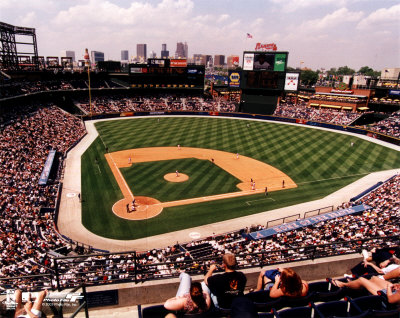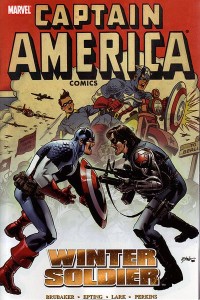Let’s try a little positivity…

One of the things I love about baseball is the relaxing atmosphere of afternoon games, particularly when broadcast from Turner Field on Peachtree TV.
I’m reading Sports Illustrated’s Great Baseball Writing and I’ve learned something from the various essays and articles in the volume – the great American pastime is always in a state of hand-wringing about the State of the Game.
Think about it. At the turn of the 20th century there was great concern over the hoodlums who played the game. The 20s were marred by gambling scandals, primarily the one revolving around the Chicago White Sox and the 1919 World Series. After that was World War II, segregation, integration, labour strife and, most recently, steroids.
There’s always a new problem plaguing the sport.
In all that doom and gloom there isn’t enough talk about what makes baseball great. I’m as guilty of this pessimism as the next person. This season alone I’ve taken shots at my hometown Toronto Blue Jays, complained about lengthy games and weighed-in on Joe Cowley and talk of moving the Jays.
So let’s get positive. Let’s talk about three things that I love about baseball.
1) Afternoon Games
Nobody likes to work during the summer. It’s a drag. Everyone would much rather be outside, enjoying the sun. Unfortunately, employment is a necessary element of being a part of today’s society.
However, baseball matinees can provide some respite from the drudgery of work. Following the game on the radio, on TV or on the Internet is always a pleasant distraction from a job.
A particular favourite of mine is to follow the Atlanta Braves on Peachtree. Their announcers are laid back and the fans at Turner Field are great. It’s always relaxing and fun to watch.
2) Tradition
I really enjoy the little social behaviours that surround baseball games. Waiting for the half inning to return to your seat after a trip to the concession stand. Judging a person’s character based on whether or not they use the real pitcher’s rubber during the opening pitch. Singing, stretching and dancing during the seventh inning stretch. They’re all good.
A particular favourite is the habit of Torontonians to boo any opposing team that dares to have a mound meeting or try to pick-off a runner. No matter what the situation, Jays fans go nuts at the very thought of another team trying to invoke strategy.
3) The Fans
Baseball fans can’t compete with other sports’ supporters in terms of passion or intensity, but they are definitely smarter. Hockey fans, as much as I love ‘em, are basically only capable of three sounds – boo, cheer and Go <team name> Go! The rest of the game is spent in a fixed state of concentration. Football and basketball fans are much the same.
However, baseball fans sing songs together, come up with chants, and best of all heckle. No matter where they’re sitting in a stadium they will yell at the top of their lungs lengthy diatribes on their target’s short-comings as a player.
Their knowledge of bench players and opposing teams runs deep too, with many fans citing the personal lives of the athlete. Remember when it was rumoured that Alex Rodrgiuez was stepping out on his wife with Madonna? Good times. Truly, a golden age of heckling.
Graphic Novel Review: Captain America: Winter Soldier vol. 1 & 2
One of my New Year’s resolutions was to read more comic books and graphic novels. Hardly a self-improvement project, I know, but I want to get down with my nerd self.
My first graphic novel of 2010 is Captain America: Winter Soldier vol. 2, allowing me to complete the first story arc of Ed Brubaker’s popular run on one of Marvel Comics’ most recognizable characters.
I’ve never been much of a Captain America fan. I prefer grittier characters like Batman or the Punisher, so his squeaky clean image never appealed to me. And since I’m Canadian, all the patriotic beats were lost on me.
But Brubaker’s Winter Soldier storyline sucked me in. I’d heard that the new Captain America series was going to be bringing back Bucky, a character who had been dead since the end of World War II, and it hooked me.
This was a Big Deal to comic fans. Bucky had been Cap’s 16-year-old sidekick during the war, but was tragically killed when a missile he was trying to disarm exploded in mid-flight. The same incident dropped Cap into the frigid North Sea, freezing him until the 1960s.
The death of Bucky had always been cited as the reason why Marvel’s superheroes don’t have teenaged sidekicks - unlike their DC counterparts - and it added a sense of realism to the company’s mythos.
For Brubaker to be retconning a fundamental element of Marvel Comics seemed like heresy, albeit an intriguing act of rebellion.
Captain America: Winter Soldier Book One and Two brings together issues 1-14 of the fifth monthly series to star Steve Rogers. They revolve around a terrorist attack that was apparently perpetrated by a mythical Cold Warrior known as the Winter Soldier who may actually be Cap’s former partner Bucky.
Resurrection storylines have become commonplace in comics, a constant recycling of characters who had been killed for dramatic effect, only to return. It’s a trend that is holding back a medium that I love. But Brubaker handles the return of the long-dead hero with a deft hand that provides not just a plausible explanation for his survival, but an engrossing story.
Interspersed with action, character moments and plot developments, Winter Soldier begins with Captain America becoming angry and frustrated with the inability of the United States government to attack countries that sponsor terrorism. The detonation of a Weapon of Mass Destruction in Philadelphia leaves a trail that leads to former Soviet general Aleksander Lukin, and his shadowy operative the Winter Soldier.
Even the name Winter Soldier is clever work by Brubaker. It’s a reference to the loyal American revolutionaries who stuck with George Washington over the harrowing winter in Valley Forge, but also to the Winter Soldier Investigation, a Viet Nam era examination of atrocities and war crimes committed by the United States Armed Forces.
Brubaker seamlessly connects the Second World War, the Cold War, modern terrorism and Captain America’s complex continuity. It’s not just that he brings in plot points from every era of Cap’s 70 years of existence, but the pacing and style of the book draws heavily on these aspects of the character’s history.
To me, a classic Captain America story has him and a partner rushing off into danger to stop a catastrophe from befalling the United States or the world. Winter Soldier is no different, with Cap rushing to stop Kronas Corporation with the Falcon riding shotgun.
Steve Epting’s art work in this series is fantastic. I can’t think of a current comics creator who makes better use of inking and colouring techniques. His characters are expressive and natural in conversation, and dynamic and fun during action scenes.
In particular, the way he draws the acrobatic Captain America jumping, rolling and bouncing in fight scenes is thrilling.
Winter Soldier breaks an old comic fan saying: “No one stays dead, except Bucky and Uncle Ben.” The phrase refers to the fact that Peter Parker’s uncle and Captain America’s sidekick must stay dead because their loss is what, in part, forms the hero we know today.
I never thought I’d see the day where that axiom was successfully reversed, but the Winter Soldier saga does it.
The return of James “Bucky” Buchanan Barnes was enough to catch my interest and buy the first volume of Captain America: Winter Soldier, and the gripping story has lead me to the rest of the series. Brubaker’s writing isn’t some gimmick. It’s some of the best mainstream superhero comic work I’ve ever read.
